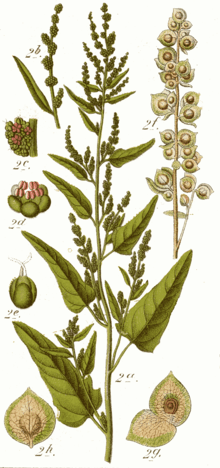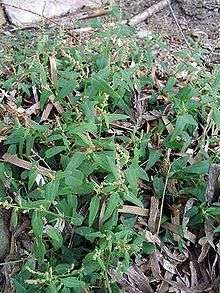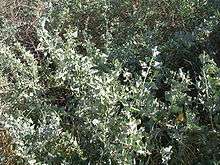Atriplex
| Atriplex | |
|---|---|
 | |
| Garden Orache (Atriplex hortensis) From Sturm & Sturm (1796): Deutschlands Flora in Abbildungen. | |
| Scientific classification | |
| Kingdom: | Plantae |
| (unranked): | Angiosperms |
| (unranked): | Eudicots |
| (unranked): | Core eudicots |
| Order: | Caryophyllales |
| Family: | Amaranthaceae |
| Subfamily: | Chenopodioideae |
| Tribe: | Atripliceae |
| Genus: | Atriplex L. |
| Species | |
|
About 250-300, see text | |
| Synonyms | |
|
Blackiella Aellen | |
Atriplex (/ˈætrᵻplɛks/[1]) is a plant genus of 250–300 species, known by the common names of saltbush and orache (or orach). It belongs to the subfamily Chenopodioideae of the family Amaranthaceae (which include the Chenopodiaceae of the Cronquist system). The genus is quite variable and widely distributed. It includes many desert and seashore plants and halophytes, as well as plants of moist environments. The generic name originated in Latin and was applied by Pliny the Elder to the edible oraches.[2] The name saltbush derives from the fact that the plants retain salt in their leaves; they are able to grow in areas affected by soil salination.
Description
.jpg)
The species in genus Atriplex are annual or perennial herbs, subshrubs, or shrubs. The plants are often covered with bladderlike hairs, that later collapse and form a silvery, scurfy or mealy surface, rarely with elongate trichomes. The alternate or rarely opposite leaves are petiolate or sessile, often persistent or tardily deciduous. The flat or slightly fleshy leaf blades are either entire, or serrate, or lobed and very variable in shape.[3][4]
The inflorescences consist of axillary or terminal spikes or spicate panicles, or axillary clusters of glomeruled flowers. The flowers are unisexual, some species are monoecious, others dioecious. Male flowers consist of 3-5 perianth lobes and 3-5 stamens. Female flowers are usually lacking a perianth, but are enclosed by 2 foliaceous bracteoles, and contain an ovary with a short style and 2 stigmas.[3][4]
In fruit, the bracteoles can enlarge, thicken or become appendaged. They enclose the fruit tightly, without becoming connate to it. The pericarp is adnate to the vertically orientated, flattened seed. The seed coat is thick, leathery or hardening. The annular embryo surrounds the perisperm.[3][4]
The chromosome base number is x = 9, except for Atriplex lanfrancoi, which is x=10.[5]
A few Atriplex species are C3-plants, but most species are C4-plants, with a characteristic leaf anatomy (kranz anatomy).[5]
Distribution and evolution
The genus Atriplex is distributed nearly worldwide from subtropical to temperate and to subarctic regions. Most species rich are Australia, North America, South America and Eurasia. Many species are halophytes and are adapted to dry environments with salty soils.[5]
The genus evolved in Middle Miocene, the C4-photosynthesis pathway developed about 14.1-10.9 million years ago, when the climate became increasingly dry. The genus diversified rapidly and spread over the continents. The C4Atriplex colonized North America probably from Eurasia during the Middle/Late Miocene, about 9.8-8.8 million years ago, and later spread to South America. Australia was colonized twice by two C4 lineages, one from Eurasia or America about 9.8-7.8 million years ago, and one from Central Asia about 6.3-4.8 million years ago. The last lineage diversified rapidly, and became the ancestor of most Australian Atriplex species.[5]
Ecology
Atriplex species are used as food plants by the larvae of some Lepidoptera species; see the list of Lepidoptera which feed on Atriplex. For spiders such as Phidippus californicus and other arthropods, saltbush plants offer opportunities to hide and hunt in habitat that is otherwise often quite barren.
Use by humans
Many species are edible. However, the favored species for human consumption is Garden Orache (A. hortensis). Use of Atriplex as food is known since at least the late Epipaleolithic (Mesolithic). The Ertebølle culture presumably used Common Orache (A. patula) as a vegetable (A. patula is attested as an archaeophyte in northern Europe). In the biblical Book of Job, mallûaḥ (מַלּ֣וּחַ, probably Mediterranean Saltbush, A. halimus, the major culinary saltbush in the region) is mentioned as food eaten by social outcasts (Job 30:4[6]). Grey Saltbush (A. cinerea) is used as bushfood in Australia since prehistoric times. Chamiso (A. canescens) and Shadscale (A. confertifolia) were eaten by Native Americans, and Spearscale (A. hastata) was a food in rural Eurasia. Common Orache seed has been found among apparent evidence of cereal preparation and cooking at Late Iron Age villages in Britain.[7]
Meat from sheep which have grazed on saltbush has surprisingly high levels of vitamin E, is leaner and more hydrated than regular lamb and has consumer appeal equal to grain-fed lamb. The vitamin E levels could have animal health benefits while extending the shelf-life and maintaining the fresh red colour of saltbush lamb. This effect has been demonstrated for Old Man Saltbush (A. nummularia) and River Saltbush (A. amnicola). For reasons unknown, sheep seem to prefer the more fibrous, less nutritious River Saltbush.[8][9]
Saltbushes are also used as an ornamental plant in landscaping and can be used to prevent soil erosion in coastal areas. Old Man Saltbush has also been successfully used to rehabilitate old mining sites around Lightning Ridge (Australia).



Atriplex lentiformis
Atriplex nummularia
Systematics
The genus Atriplex was first described in 1753 by Carl Linnaeus.[10] The type species (lectotype) is Atriplex hortensis.[11]
Atriplex is an extremely species rich genus and comprises about 250[4]-300[5] species. After phylogenetical research, Kadereit et al. (2010) excluded Halimione as a distinct sister genus. The remaining Atripex species were grouped into several clades, that mostly are not identical with the traditional sections:[5]
- Atriplex lanfrancoi/cana-Clade:
- Atriplex section Atriplex: annual C3-plants.
- Atriplex aucheri Moq.: in Eastern Europe and West Asia
- Atriplex hortensis L. – Garden Orache, Red Orach, Mountain Spinach, French Spinach: in Asia, cultivated or naturalized in Europe
- Atriplex oblongifolia Waldst. & Kit. – Oblong-leaved Orache: in Eurasia
- Atriplex sagittata Borkh. (Syn.: Atriplex nitens Schkuhr): in Eurasia
- Atriplex section Teutliopsis Dumort.: annual C3-plants
- Atriplex australasica Moq.
- Atriplex calotheca (Rafn) Fr.: in Northern Europe
- Atriplex crassifolia Ledeb.: in Asia
- Atriplex davisii Aellen: from Southern Europe to Egypt
- Atriplex glabriuscula Edmondston – Northeastern Saltbush, Babington's Orache, Smooth Orache, Scotland Orache, Glabrous Orache: In Central and Northern Europe
- Atriplex gmelinii C.A. Mey. ex Bong. – Gmelin's Saltbush: in Asia and North America
- Atriplex intracontinentalis Sukhor.: from Central Europe to Asia
- Atriplex laevis C.A. Mey.: in Asia, naturalized in Eastern Europe
- Atriplex latifolia Wahlenb.: in Eurasia
- Atriplex littoralis L. – Grass-leaved Orache: in Eurasia and North Africa
- Atriplex longipes Drejer – Long-stalked Orache: in Northern Europe
- Atriplex micrantha C.A. Mey.: in Asia, naturalized in Europe
- Atriplex nudicaulis Boguslaw – Baltic Saltbush: in Eurasia
- Atriplex patula L. – Common Orache, Spreading Orache: in Eurasia and North Africa
- Atriplex praecox Hülph. – Early Orache>: in Northern Europe
- Atriplex prostrata Moq. – Spear-leaved Orache, Thin-leaved Orache, Triangle Orache, fat hen: in Eurasia and North Africa
- C4-Atriplex-Clade: containing the majority of species. The traditional classification into sections (sect. Obione, sect. Pterochiton, sect. Psammophila, sect. Sclerocalymma, sect.Stylosa) did not reflect the phylogenetical relationships and was rejected by Kadereit et al. (2010).[5]
- Atriplex acanthocarpa (Torr.) S. Watson: in North America
- Atriplex acutibractea Anderson: in Australia
- Atriplex altaica Sukhor.: in Asia
- Atriplex angulata Benth.: in Australia
- Atriplex billardierei (Moq.) Hook. f.: in Australia
- Atriplex canescens (Pursh) Nutt. – Chamiso, Chamiza, Four-winged Saltbush, Grey Sagebrush: in North America
- Atriplex centralasiatica Iljin: in Asia
- Atriplex cinerea Poir. – Grey Saltbush, Truganini:[12] in Australia
- Atriplex codonocarpa P.G. Wilson: in Australia
- Atriplex conduplicata F. Muell.: in Australia
- Atriplex confertifolia (Torr. & Frém.) S. Watson – Shadscale (Saltbush): in North America
- Atriplex cordobensis Gand. & Stuck.: in South America
- Atriplex deserticola Phil.: in South America
- Atriplex dimorphostegia Kar. & Kir.: in North Africa
- Atriplex eardleyae Aellen: in Australia
- Atriplex elachophylla F. Muell.: in Australia
- Atriplex fissivalvis F. Muell.: in Australia
- Atriplex flabellum Bunge ex Boiss.: in Eurasia
- Atriplex gardneri (Moq.) D. Dietr. – Gardner's saltbush, Moundscale: in North America
- Atriplex glauca L.: in Portugal, Spain and in North Africa
- Atriplex halimus L. – Mediterranean Saltbush, Sea Orache, Shrubby Orache: in South Europe, North Africa and Southwest Asia
- Atriplex herzogii Standl.: in North America
- Atriplex holocarpa F. Muell.: in Australia
- Atriplex hymenelytra (Torr.) S. Watson – Desert Holly: in North America
- Atriplex hymenotheca Moq.: in Australia
- Atriplex imbricata (Moq.) D. Dietr.: in South America
- Atriplex inamoena Aellen: in Eurasia
- Atriplex intermedia Anderson: in Australia
- Atriplex isatidea Moq.: in Australia
- Atriplex laciniata L. – Frosted Orache: In Western and Northern Europe
- Atriplex lampa (Moq.) Gillies ex Small: in South America
- Atriplex lehmanniana Bunge: in Eurasia
- Atriplex lentiformis (Torr.) S. Watson – Quail Bush: in North America
- Atriplex leptocarpa F. Muell.: in Australia
- Atriplex leucoclada Boiss.: in Eurasia
- Atriplex leucophylla (Moq.) D. Dietr.: in North America
- Atriplex lindleyi Moq.: in Australia
- Atriplex moneta Bunge ex Boiss.: in Eurasia
- Atriplex muelleri Benth.: in Australia
- Atriplex nessorhina S.W.L. Jacobs: in Australia
- Atriplex nummularia Lindl. – Old Man Saltbush, Giant Saltbush: in Australia
- Atriplex obovata Moq.: in North America
- Atriplex pamirica Iljin: in Eurasia
- Atriplex parishii S. Watson: in North America
- Atriplex parryi S. Watson: in North America
- Atriplex parvifolia Kunth: in South America
- Atriplex patagonica (Moq.) D. Dietr.: in South America
- Atriplex phyllostegia (Torr. ex S. Watson) S. Watson: in North America
- Atriplex polycarpa (Torr.) S. Watson – Allscale (Saltbush), Desert Saltbush, Cattle Saltbush, Cattle Spinach: in North America
- Atriplex powellii S. Watson – Powell's Saltbush: in North America
- Atriplex pseudocampanulata Aellen: in Australia
- Atriplex quinii F. Muell.: in Australia
- Atriplex recurva d'Urv.: in Eurasia, endemic to areas around the Aegean
- Atriplex rhagodioides F. Muell.: in Australia
- Atriplex rosea L. – Tumbling Orache: in Eurasia and North Africa
- Atriplex rusbyi Britton ex Rusby: in South America
- Atriplex schugnanica Iljin: in Asia
- Atriplex semibaccata R. Br. – Australian Saltbush, Berry Saltbush, Creeping Saltbush: in Australia
- Atriplex semilunaris Aellen: in Australia
- Atriplex serenana A. Nelson ex Abrams: in North America
- Atriplex sibirica L.; in Asia, naturalized in Europe
- Atriplex sphaeromorpha Iljin: in Russia, Ukraine and Caucasus
- Atriplex spinibractea Anderson: in Australia
- Atriplex spongiosa F. Muell.: in Australia
- Atriplex stipitata Benth.: in Australia
- Atriplex sturtii S.W.L. Jacobs: in Australia
- Atriplex suberecta I. Verd. – sprawling saltbush, lagoon saltbush: in Australia
- Atriplex tatarica Aellen: in Europe, North Africa and Asia
- Atriplex turbinata (Anderson) Aellen: in Australia
- Atriplex undulata (Moq.) D. Dietr.: in South America
- Atriplex velutinella F. Muell.: in Australia
- Atriplex vesicaria Heward ex Benth. – Bladder Saltbush: in Australia
Selected species not yet investigated phylogenetically:
|
|
Excluded species:
- Extriplex:[13]
- Extriplex californica (Moq.) E.H.Zacharias (Syn. Atriplex californica Moq.)
- Extriplex joaquiniana (A.Nelson) E.H.Zacharias (Syn. Atriplex joaquiniana A.Nelson)
- Halimione Aellen:[5]
- Halimione pedunculata (L.) Aellen (Syn.: Atriplex pedunculata L.)
- Halimione portulacoides (L.) Aellen (Syn.: Atriplex portulacoides L.)
- Halimione verrucifera (M.Bieb.) Aellen (Syn.: Atriplex verrucifera M.Bieb.)
- Stutzia E.H.Zacharias:[13]
- Stutzia covillei (Standl.) E. H. Zacharias (Syn. Atriplex covillei (Standl.) J. F. Macbr.)
- Stutzia dioica (Nutt.) E. H. Zacharias (Syn. Atriplex suckleyi (Torrey) Rydberg, Atriplex ovata (Rydb.) Clem. & E. G. Clem.)
References
- ↑ Sunset Western Garden Book, 1995:606–607
- ↑ Quattrocchi, Umberto (2000). CRC World Dictionary of Plant Names. I: A-C. CRC Press. p. 232. ISBN 978-0-8493-2675-2.
- 1 2 3 Stanley L. Welsh: Atriplex - online, In: Flora of North America Editorial Committee (ed.): Flora of North America North of Mexico, Volume 4: Magnoliophyta: Caryophyllidae, part 1., Oxford University Press, New York. 2003, ISBN 0-19-517389-9.
- 1 2 3 4 Gelin Zhu, Sergei L. Mosyakin & Steven E. Clemants: Chenopodiaceae: Atriplex - online, In: Wu Zhengyi, Peter H. Raven, Deyuan Hong (ed.): Flora of China, Volume 5: Ulmaceae through Basellaceae., Science Press und Missouri Botanical Garden Press, Beijing und St. Louis, 2003, ISBN 1-930723-27-X.
- 1 2 3 4 5 6 7 8 Gudrun Kadereit, Evgeny V. Mavrodiev, Elizabeth H. Zacharias & Alexander P. Sukhorukov: Molecular phylogeny of Atripliceae (Chenopodioideae, Chenopodiaceae): Implications for systematics, biogeography, flower and fruit evolution, and the origin of C4 Photosynthesis. - American Journal of Botany 97(10): 1664-1687, 2010.
- ↑ Mistranslated as "mallows" in the King James Bible and as Nesseln (nettles) in the Luther Bible
- ↑ Christopher Evans (2015), North West Cambridge Archaeology: University of Cambridge 2013 Excavations, The Traveller's Rest Sub-site (PDF), Cambridge Archaeological Unit University Of Cambridge, pp. 100–113
- ↑ Norman, Hayley C.; Freind, Colby; Masters, David G.; Rintoul, Allan J.; Dynes, Robyn A. & Williams, Ian H. (2004): Variation within and between two saltbush species in plant composition and subsequent selection by sheep. Aust. J. Agr. Res. 55(9): 999–1007. doi:10.1071/AR04031 (HTML abstract)
- ↑ Pearce, Kelly & Jacob, Robin (2004): Saltbush lifts sheep meat vitamin content. Farming Ahead 153(October): 63. PDF fulltext
- ↑ Carl Linnaeus (1753), "Atriplex", Species Plantarum 2, Lars Salvius/Biodiversity Heritage Library, pp. 1052–1054, retrieved 19 May 2015
- ↑ Atriplex at Tropicos, accessed 2013-07-11
- ↑ Tasmanian name, also transcribed trucanini, trucaninny, trugannini, trugernanna, etc. The plant was the namesake for Truganini, among the last of her people.
- 1 2 Elizabeth H. Zacharias, Bruce G. Baldwin (2010): A Molecular Phylogeny of North American Atripliceae (Chenopodiaceae), with Implications for Floral and Photosynthetic Pathway Evolution. In: Systematic Botany 35(4), p.839-857. doi:10.1600/036364410X539907
- Davidson, Alan (1999): Orach. In: Oxford Companion to Food: 556. ISBN 0-19-211579-0
- Everitt, J.H.; Lonard, R.L.; Little, C.R. (2007). Weeds in South Texas and Northern Mexico. Lubbock: Texas Tech University Press. ISBN 0-89672-614-2
External links
| Wikimedia Commons has media related to Atriplex. |
| Wikispecies has information related to: Atriplex |
- "Atriplex L.". Integrated Taxonomic Information System.
- "Atriplex". National Center for Biotechnology Information (NCBI).
- "genus Atriplex". Germplasm Resources Information Network (GRIN) online database.
- IUCN link: Atriplex threatened species

